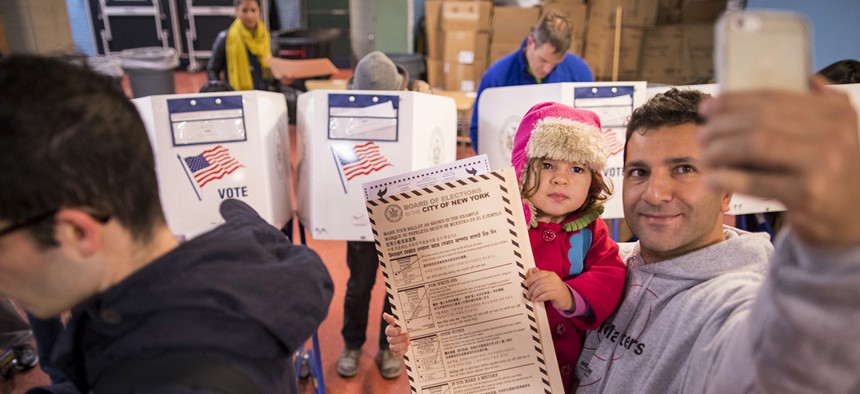Are Ballot Selfies Legal? A Guide

A man takes a selfie with his child as he waits to vote at a polling station in the Brooklyn borough of New York, Tuesday, Nov. 8, 2016. Alexander F. Yuan/AP
Today, as Americans head to the polls, some are snapping photos of their ballots to document the long-awaited culmination of the 2016 election.
Ah, the selfie. No news cycle is complete without it. Today, as Americans head to the polls, some are snapping photos of their ballots to document the long-awaited culmination of the 2016 election. Among them is Eric Trump, who this morning tweeted a photo of his vote for Republican candidate Donald Trump (he veered outside the lines a little filling in the bubble), with the caption, “It is an incredible honor to vote for my father!” Alas, poor Eric has since deleted the tweet. It probably broke the law.
“Ballot selfies” are illegal in 18 U.S. states, according to an analysis by the AP. The reasons range from protecting voters’ “right to cast a ballot in secrecy and in private” (Alabama) to the fear that ballot photos could influence a vote (South Dakota). In New York, where Eric Trump cast his ballot, photos that show completed ballots or otherwise indicate how someone cast their vote aren’t allowed.

Ballot selfies are permitted in 19 states and the District of Columbia, either explicitly or because no law bans them. In the remaining 13 states, the rules are less clear. In Iowa, for example, it’s illegal to use cameras, cellphones and other electronic devices in voting booths, but photos of absentee ballots are OK. In Delaware, voters aren’t supposed to use their cellphones in booths, but elections commissioner Elaine Manlove told the AP, “I don’t know that we can control what happens behind the curtain.”
So, if you’re headed to the polls and thinking about taking a selfie, be sure to consult our handy map first. Or just take a piece of advice from Justin Timberlake, and play it safe.
On the importance of voting... and pizza. #JTonFallon https://t.co/h575SjGftQ pic.twitter.com/0cIZmdFwQO
— Justin Timberlake (@jtimberlake) October 28, 2016
NEXT STORY: IG: USPS at risk of unauthorized network access





